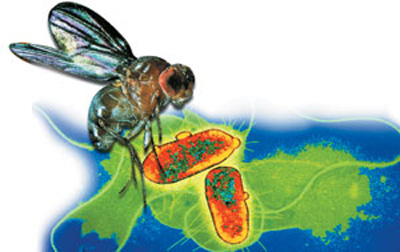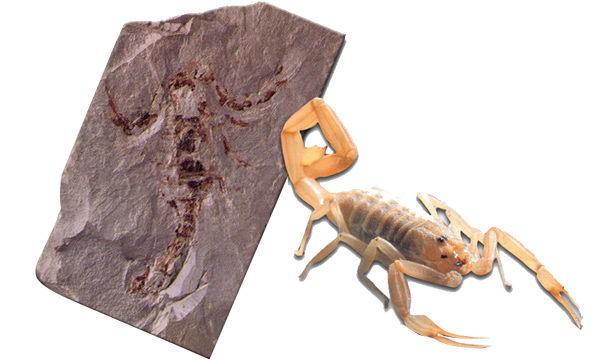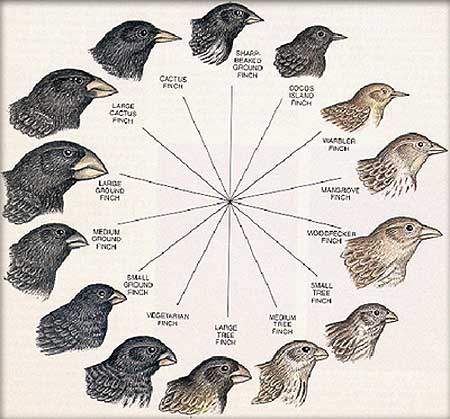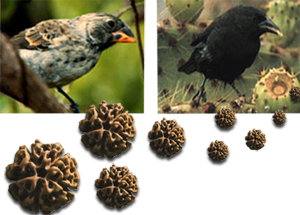The NAS’s Errors Regarding Speciation
Science and Creationism also deals with speciation, another of the classic errors of the evolutionists (Science and Creationism, p. 10). According to this booklet, "Scientists also have gained an understanding of the processes by which new species originate." In this view, living things exposed to geographic isolation—in other words separated from one another by geographical borders—become increasingly different from the other members of the group they have split away from, as a result of mutation, natural selection, and other processes. The result is that new species eventually emerge. Or so the NAS claims. However, the fact is that the process referred to here leads not to the emergence of new species, but rather to variation—in other words to different forms within a single species. What is misleading here is that the evolutionists use the concept of "species"—which is in any case subject to debate—in a manner to suit their theory.

Different experts in various areas of biology offer differing definitions of "species." The biologist John Endler makes the following comment about the chaos these various definitions have caused:
Species are "tools that are fashioned for characterizing organic diversity" (Lewin, 1979). Just as there are a variety of chisels made for different purposes, different species concepts are best for different purposes; and just as it is inadvisable to use a carving chisel to cut a mortise, problems arise when one species concept is used when it is inappropriate. Confusion and controversy have often resulted because different people working with different groups of organisms mean different things by "species."1
Professor Ali Demirsoy, a prominent proponent of Darwinism in Turkey, expresses this fact in these terms:
The question of along which lines the species, taken as the basic unit in the classification of animals and plants, should be distinguished from other species, in other words the definition of "species," is one of the hardest questions for biology to answer. To give a definition which applies to all animal and plant groups appears impossible in the present state of our knowledge.2
The word species generally brings to mind kinds such as dogs, horses, spiders, dolphins, and apples. The theory of evolution's claims regarding the "origin of species" bring to mind the origin of these life forms. Biologists, however, define "species" in a different way. According to modern biology, a living species is a population consisting of individuals which can mate and reproduce amongst themselves. This definition separates groups of living things that we think of as single species in daily life, into many more species. For instance, some 34,000 species of spider have been described.3

Some 34,000 species of spider have been identified.
In order to understand the deception in evolutionary theory with regard to speciation, "geographic isolation" first needs to be clarified. In every living species there are differences stemming from genetic variation. If a natural obstacle such as a mountain range, a river, or the sea comes between two populations belonging to a given species, and the populations thus become "isolated" from one another, then in all probability different variants will begin to dominate the two separated groups.4 For instance, variant A, a dark-colored and long-haired variation, might come to dominate one group, while variant B, a shorter-haired and lighter-colored variation, might become predominant in the other. The more the two populations are separated from one another, the more the two variants become distinct. Cases of variation like these, with distinguishing morphological differences among subgroups of the same species, are known as "subspecies."
Here the speciation claim enters the picture. Sometimes it happens that when variants A and B, after having split away from each other due to geographical isolation, are brought back together in some way but are unable to reproduce with each other. Since they are unable to reproduce, they cease being subspecies, according to the modern biological definition of "species," and become separate species. This is known as "speciation."
Evolutionists, however, make the following unwarranted inference: "There are some cases of speciation in nature by natural means; therefore, all species emerged in this way." However, there is a major deception concealed within this argument.
Two important elements of this deception are:
1) Variants A and B, geographically isolated from one another, may not be able to reproduce when they come together. Yet this generally stems from "mating behavior" differences. In other words, individuals belonging to variants A and B do not mate because they regard the other variant as foreign to themselves. However, there is no genetic impediment to their reproducing. For that reason, they are still members of the same species from the point of view of genetic information. (In fact, for this reason the concept of "species" continues to be the subject of debate in biology.)
2) The really important point is that the "speciation" in question is not an increase in genetic information, but on the contrary stems from a loss of such information. The reason for the differentiation is not that new genetic information has been added to one or other of the variants. There is no such addition. For instance, neither of the variants acquires a new protein, enzyme, or organ. There is no "development" here. On the contrary, instead of a population which had previously harbored different sets of genetic information (in our example, a population possessing both long and short hair, as well as both light and dark colors), now there are two populations that are both impoverished from the point of view of genetic information.

How did living species first come into being? How did the bacterial, protist, fungus, plant, and animal worlds first emerge on the Earth? How did phyla—the highest taxonomic category (for example, chordates and molluscs)—as well as classes (mammals and birds), orders (primates and carnivores), and families (cats and dogs) first come about? These are the questions which evolutionists really need to answer.
For this reason, nothing about speciation supports the theory of evolution. The theory of evolution claims that living species evolved from one another,
from the simpler to the more complex, completely by chance. For the theory to be taken seriously, therefore, it needs to posit a mechanism for increasing genetic information. It needs to be able to explain how living things without eyes, ears, hearts, lungs, wings, feet, and other organs and systems came to acquire them, and where the genetic information describing such systems and organs came from. A mechanism that divides an already-existing species into two groups, each of which undergoes a loss of genetic information, clearly has nothing to do with this.
This is in fact accepted by evolutionists. For this reason, they define variations within a species and instances of speciation by division of a population into two parts as "microevolution." Microevolution is used in the sense of variations occurring within an already existing species. Yet the inclusion of the term "evolution" in this description is a deliberate deception. There is no evolutionary process here at all, not even a "micro" one. This process merely distributes genetic information that already exists within the genetic pool among a different combination of individuals.
The questions that need to be answered are these: How did the living categories first come into being? How did the kingdoms of the Monera (bacteria), Protista (amoebas), Fungi (mushrooms), Plantae, and Animalia come into being? How did the higher taxonomical categories of families (cats and dogs), orders (carnivores and primates), classes (birds and mammals), and phyla (chordates, arthropods, and molluscs) first come into being? These are the issues that evolutionists need to be able to explain.
Evolutionists describe their theories concerning the origin of these basic categories as "macroevolution." It is actually macroevolution which is intended when the theory of evolution is referred to. That is because the genetic variations known as microevolution are an observed biological phenomenon accepted by everyone, but one which has nothing to do with evolution itself (in spite of the name), as we have seen above. As far as the claim of macroevolution is concerned, there is no evidence for it at all, either in observational biology or in the fossil record.

There is an absolutely essential point to be made here. Those with insufficient knowledge in this area may be deceived into thinking that "Since microevolution takes place in a very short space of time, macroevolution could also occur given tens of millions of years." Some evolutionists do indeed make this mistake, or else attempt to use this error to make others believe in the theory of evolution. This is the form that all of Charles Darwin's "proofs of evolution" in The Origin of Species take. The examples put forward by subsequent evolutionists are all along the same lines, as well. In all of these examples, the genetic variation known to evolutionists as microevolution is used as proof of the theory they describe as macroevolution.
Let us give an example to illustrate the error in this reasoning. What would you say if someone proposed to you the following argument? "A bullet fired into the air from a pistol travels at 400 km (250 miles) an hour. It will therefore shortly leave the Earth's atmosphere and reach the moon, and in the weeks that follow will eventually arrive at the planet Mars."
If someone made such a claim to you, you would immediately realize that it was a simple deception. The person making the claim is expressing only a very narrow observation (about the speed of the bullet leaving the pistol) and is concealing two basic facts, gravity and friction, which restrict the progress of the bullet. All evolutionists' attempts to derive macroevolution from microevolution employ exactly the same method.
The upshot of this micro/macro evolution debate and evolutionists' "speciation" fairytales is this: Living things emerged on the Earth as "kinds" possessing structures that differed from one another. (The fossil record demonstrates this.) Within these kinds, variants and subspecies may appear thanks to the richness of their genetic pools. For instance, the "rabbit" type contains white-haired and grey-haired, and long-eared and short-eared, variants within itself, and these have spread according to the prevailing natural conditions. However, kinds can never turn into each other. There is no natural mechanism that can design new kinds, or that can form new organs, systems, or body plans within a type. Each kind was created with its own peculiar structure, and since God has created them all with a rich variation potential, every kind produces a rich, but restricted, range of variation.
Evolutionists' Confessions About Speciation

Theodosius Dobzhansky
Apart from "amateur" evolutionists who have only a superficial knowledge of the subject and such dogmatic evolutionists as the members of the National Academy of Sciences, almost all Darwinists are very well aware of the fundamental problem: to account for the origin of living kinds and the diversity of life. As Theodosius Dobzhansky, one of the architects of neo-Darwinism, wrote in the introduction to his Genetics and the Origin of Species, the main problem facing evolution is the variety of life.5
This is the subject that Charles Darwin and his followers need to illuminate. In his book The Origin of Species, Darwin offers no concrete evidence, only speculation. One letter in The Life and Letters of Charles Darwin, published by his son Francis Darwin, admits the truth of this:
When we descend to details, we can prove that no one species has changed.6
Darwin hoped that with the passage of time and advances in scientific research, an answer to the question would be found and speciation would be proved. On the contrary, however, scientific discoveries have disproved Darwin. Despite the best efforts of evolutionists, over the ensuing 150 years or so the idea of speciation by evolutionary mechanisms has remained a claim devoid of any evidence or foundation.
Some space will now be devoted to confessions made by evolutionists on this subject.

In an article published in the journal Nature in 2001, Professor Richard Harrison of Cornell University summed up the evolutionist past on this subject:
…[N]atural communities harbour an enormous variety of species… But what of the origin of diversity? Much less has been written about how new species arise—although the process of speciation is central to evolutionary biology.7

Richard Harrison
It is actually no surprise that "very little" should have been written on this subject. Scientific discoveries have revealed that it is impossible for one species to turn into another and that change happens only within a species and within specific bounds. There has not so far been one single observable instance of speciation by evolutionary mechanisms.
In his book Sudden Origins: Fossils, Genes and the Emergence of Species, published in 2000, Jeffrey Schwartz, Professor of Anthropology at the University of Pittsburgh, stresses this fact:
... It was and still is the case that, with the exception of Dobzhansky's claim about a new species of fruit fly, the formation of a new species, by any mechanism, has never been observed.8
In the face of these facts, some evolutionists offer an explanation along the lines of "We cannot observe speciation by means of evolution because evolutionary mechanisms only act over very long periods of time. For that reason speciation cannot be observed in nature or in the laboratory." However, this, too, is nothing but a rationalization with no scientific basis. That is because no sign of speciation has been seen in fruit flies or bacteria, which have very short life spans, thus making it possible for a single scientist to observe thousands of generations. To date, countless experiments and studies on various microorganisms and animal species have destroyed evolutionists' dreams. One evolutionist, Kevin Kelly, the editor of Wired magazine and chairman of the All Species Foundation, describes this:

No case of speciation has ever been seen in creatures such as fruit flies or bacteria, of which thousands of generations can be observed by scientists due to their short life spans.
Despite a close watch, we have witnessed no new species emerge in the wild in recorded history. Also, most remarkably, we have seen no new animal species emerge in domestic breeding. That includes no new species of fruitflies in hundreds of millions of generations in fruitfly studies, where both soft and harsh pressures have been deliberately applied to the fly populations to induce speciation… In the wild, in breeding, and in artificial life, we see the emergence of variation. But by the absence of greater change, we also clearly see that the limits of variation appear to be narrowly bounded, and often bounded within species.9
In order to demonstrate speciation, fruit flies have been bred for the last 70 years or so. These have constantly been exposed to mutations, yet no evolutionary change has been experienced, and no form of speciation encountered. Fruit flies have remained fruit flies.10 In the same way, experiments and studies on the bacterium Escherichia coli down the years have revealed no new bacteria, much less multicellular organisms. E. coli have remained E. coli.11
However, the difficulties facing evolutionists are not restricted to such observations and experiments: the fossil record also definitively rejects the concept of speciation. There is absolutely no sign in the record of the countless intermediate species that should have once lived according to Darwinism. It has now been acknowledged that Darwin's claim that these fossils would be found in the future is definitely incorrect. Evolutionists now offer the excuse that "speciation is so rapid that it cannot be seen in the fossil record" or, to put it more accurately, they attempt to console themselves with that thought.

The approximately 300-millionyear old Paraisobuthus (scorpion) fossil is identical to the present-day scorpion.


Kevin Kelly and his book Out of Control: The New Biology of Machines, Social Systems, and the Economic World.
In brief, subjects such as the origin of species, the emergence of species, and the variety of life cannot be accounted for by natural processes and random effects as maintained by the theory of evolution. Moreover, scientific discoveries prove that Darwinism is an unscientific and unrealistic theory. A great many scientists today are aware of this. Yet, out of a fear of being excluded from the scientific community, very few biologists openly express such views. One of those who do is the well-known Professor Lynn Margulis of the University of Massachusetts. Margulis states that Darwinism's claims on this subject are "completely mistaken." Margulis's views were also cited in Kevin Kelly's book, Out of Control: The New Biology of Machines, Social Systems and the Economic World:
"It is totally wrong. It's wrong like infectious medicine was wrong before Pasteur. It's wrong like phrenology is wrong. Every major tenet of it is wrong," said the outspoken biologist Lynn Margulis about her latest target: the dogma of Darwinian evolution. [With her theses], Margulis was . . . denouncing the modern framework of the century-old theory of Darwinism, which holds that new species build up from an unbroken line of gradual, independent, random variations. Margulis is not alone in challenging the stronghold of Darwinian theory, but few have been so blunt.12
David Tilman, of the Department of Ecology, Evolution and Behavior at the University of Minnesota, summed the matter up most appropriately in an article published in Nature on May 11, 2000: "The existence of so great a diversity of species on Earth remains a mystery."13
The Myth of the Evolving Finches

Science and Creationism says "A particularly compelling example of speciation involves the 13 species of finches studied by Darwin on the Galápagos Islands, now known as Darwin's finches." (Science and Creationism, p. 10) The fact is, however, that Darwin's finches are an instance not of speciation, but of variation.
During his trip on the Beagle, Darwin studied different finch species on the Galápagos Islands, later attributing the differences in beak size and feeding habits amongst these birds to evolution. Thirteen species live on the Galápagos Islands themselves and one species on Cocos Island, some 600 kilometers to the northeast. Although these birds are classified into 14 different species, they closely resemble one another, possessing similar body shapes, colors, and habits. In Science and Creationism, it is suggested that these birds evolved from a single species that came from South America. Ever since Darwin, evolutionists have been portraying these birds as an example of evolution by means of natural selection and the best-known proof of evolution. This chapter will explain that the different species of finch do not represent evidence of evolution, and show how evolutionists attempt to portray them as such by misinterpreting the facts.
Why Finches?

14 different species of finch.
Darwin wrote in his Origin of Species that the emergence of new species by means of natural selection is a very slow process, which is why it cannot be observed, but only inferred. This, however, was not acceptable to the developing standards of modern science. In order to maintain their claims that the theory of evolution is actually scientific, Neo-Darwinists began looking for new "proofs." At this point, the story of the Galápagos finches appeared as a savior.
These birds thus became the focus of wide-ranging research. A number of evolutionists made statements based on their own observations. In an article in the April 1953 edition of Scientific American magazine, the ornithologist David Lack claimed that the evolution of the birds on the Galápagos had taken place in the recent past, and that this could even be seen as proof of differentiation between species.14 Another evolutionist, Peter Grant, suggested that the evolution of the Galápagos finches was still going on.15
The names of Peter Grant and his wife Rosemary Grant can be found in most articles and writings about the finches in question. In fact, the claims made about the finches in Science and Creationism are actually based on the Grants' work. These two researchers first went to the Galápagos Islands in 1973, with the aim of observing the effects of evolution on the finches, and carried out detailed studies and observations in the following years. They are thus remembered as experts on Darwin's finches.16
Peter and Rosemary Grant's Errors

Peter Grant and his wife, both from the Department of Ecology and Evolutionary Biology at Princeton University, studied individual members of the medium ground finch species on the Galápagos for years, and regularly monitored some 20,000 finches across several generations. In addition, the Grants and their team constantly measured the amount of rainfall on the islands and studied the effects of different climates on birds.
At this point we need to make a brief mention of the climatic conditions on the Galápagos Islands. Generally speaking, the islands enjoy a hot and rainy climate from January to May; on some islands, a cooler and drier climate prevails. Total rainfall levels during the warm and rainy season vary widely from year to year. Furthermore, atmospheric events known as "El Niño," which occur at irregular intervals and various intensities every two to 11 years, alter the climatic balances. During times of El Niño, an excessive amount of rain falls on the Galápagos, while the years which follow are generally dry and rainless.
The amount of rain is of vital importance for the finches, which feed on seeds. In years when rain is plentiful, the finches can easily find the seeds they need to grow and reproduce. In years of drought, however, the number of seeds produced by plants is limited and may not be enough; as a result some finches die of starvation.

Left, Medium Ground Finch
Right,Cactus Finch
Grant and his colleagues measured the rainfall on Daphne Major, one of the Galápagos, as normal in 1976, but as only one-fifth of that level in 1977. In the period of drought which began in the middle of 1976 and lasted until the rain began again in January 1978, they observed a severe drop in the amount of seeds on the island and noticed that a number of ground finches had disappeared—to such an extent, in fact, that the ground finch population fell by 15% over the preceding year. They assumed that most of the vanished birds had died, and that a few had migrated.
Grant and his team also recorded that those finches which survived after the drought had rather larger bodies and deeper beaks than normal. The average depth of ground finch beaks on the island—in other words, the distance between the top and bottom of the beak at the point where the beak joins the body—was approximately half a millimeter, or 5%, larger in 1977 compared to 1976. Taking this as their starting point, the researchers suggested those finches which fed solely on small seeds were weeded out, while those with beaks capable of breaking and opening larger and harder shells survived.
In an article in the journal Scientific American published in October 1991, Peter Grant declared that this research was direct proof of evolution. According to Grant, 20 selection events were sufficient to turn the medium ground finch into the large ground finch; if it is assumed that there is a drought every 10 years, then such a change could happen in as little as 200 years. He maintained that, with the addition of a margin of error, it might take 2,000 years, but that bearing, in mind the long time the birds had been on the island, even that figure might be too short. A greater period of time was required for natural selection to turn the medium ground finch into the cactus-eating finch.17 Grant renewed his claims in subsequent articles, insisting that finches had verified Darwinism and proved that natural selection caused living things to evolve.18

Avıew of the Galápagos Islands
These statements were regarded as a salvation in evolutionist circles: the theory of evolution by natural selection, which had always failed in experiments and observations, was portrayed as having been proved. Grant's research was the theme of Jonathan Weiner's Pulitzer Prize–winning book The Beak of the Finch. With this book, Peter and Rosemary Grant were made the icons of Darwinism.
It is true that Professor Grant and his team put in a lot of work in the Galápagos Islands. Yet, for some reason their care and attention in the field were not reflected when it came to analyzing their results. They made a serious error by evaluating their discoveries not in the light of science, but in that of their evolutionist preconceptions.
Let us now consider the evolutionists' errors on this subject, especially those of Professor Grant and the National Academy of Sciences.
The Error of Extrapolating the Change in Finches' Beaks

As we have already made clear, El Niño affects the western regions of North and South America once every few years, and there is heavy rainfall in the Galápagos Islands at such times. This leads to luxurious plant growth and abundant seeds. Finches are thus easily able to obtain the seeds they need. Their numbers therefore increase during rainy periods.
Grant and his colleagues witnessed just such a situation in 1982-1983. With the rain there was an abundance of seeds, and the beak size in medium ground finches returned to its previous value to before the drought of 1977. This astonished evolutionists, who were expecting regular growth in beak size.
The explanation for the change in the average size of the Galápagos finches' beaks is this: in years of drought when seeds are scarce birds with beaks slightly larger than the average are able to use these more powerful beaks to open the remaining hard and large seeds. Weak individuals and finches with small beaks die off since they are unable to adapt to the prevailing conditions. In this way, the average beak size goes up. During periods of heavy rain, when small and soft seeds are plentiful, the situation is reversed. Under these conditions, those finches with small beaks are able to adapt to the prevailing conditions, and their numbers rise. The average beak size thus returns to normal. Peter Grant and his student Lisle Gibbs actually accepted this in an article published in Nature magazine in 1987.19
In short, the findings show that there is no such thing as evolutionary change. Average beak size sometimes rises above a fixed value according to the seasons and sometimes falls—in other words, it fluctuates. As a result, there is no directional change.
Peter Grant realized this, and wrote, "the population, subjected to natural selection, is oscillating back and forth."20 Some evolutionist researchers also state that natural selection had flipped.21
Danny Faulkner, a professor of astronomy and physics from the University of South Carolina, says that this fluctuation in beak size is no evidence for evolution:
And so if you have supposed microevolution one direction and then later it reverts right back to where it started from, that's not evolution, it can't be.22
Therefore, any increase or reduction in the size of finches' beaks depending on food resources proves nothing in regard to evolution. Evolutionists' belief that they have found proof of evolution in the oscillation in finch beak sizes is a purely ideological one.

Jonathan Wells
Grant and his team analyzed thousands of ground finches (Geospiza fortis) from the 1970s until the 1990s and found no tendency towards either a net increase or reduction in beak size. Moreover, no new species or feature appeared, and there was no change in any specific direction. This is what the observations show. The duty of an objective scientist is to report these facts without distorting them or engaging in speculation. It is unacceptable to exaggerate this phenomenon or distort its meaning solely for the sake of producing evidence for evolution. Yet, Professor Grant made a totally contradictory analysis, claiming a phenomenon he did not observe—namely, that a species of finch could turn into another species in as little as from 200 to 2,000 years, and thus casting a shadow over his entire study. As the biologist Dr. Jonathan Wells puts it, this is "exaggerating the evidence."23
Wells states that Darwinists frequently resort to such methods and cites examples of statements in Science and Creationism, saying:
A 1999 booklet published by the National Academy describes Darwin's finches as "a particularly compelling example" of the origin of species. The booklet goes on to explain how the Grants and their colleagues showed "that a single year of drought on the islands can drive evolutionary changes in the finches," and that "if droughts occur about once every 10 years on the islands, a new species of finch might arise in only about 200 years."
That's it. Rather than confuse the reader by mentioning that selection was reversed after the drought, producing no long-term evolutionary change, the booklet simply omits this awkward fact. Like a stock promoter who claims a stock might double in value in twenty years because it increased 5 percent in 1998, but doesn't mention that it decreased 5 percent in 1999, the booklet misleads the public by concealing a crucial part of the evidence.24
It is astonishing that an institution such as the National Academy of Sciences, which claims to be scientifically trustworthy, would perpetrate such a deception in order to provide evidence for evolution in finches and for natural selection in general. In this regard, professor Phillip Johnson of the University of California at Berkeley says the following in an article on the subject in the Wall Street Journal:
When our leading scientists have to resort to the sort of distortion that would land a stock promoter in jail, you know they are in trouble.25
To sum up, this story of the Galápagos finches, which is claimed to be one of "the most impressive examples of evolution by natural selection," is in fact a clear case of deception. It is also one of hundreds of examples showing that evolutionists will resort to all kinds of unscientific methods.
NOTES
1. J.A. Endler, "Conceptual and Other Problems in Speciation", D. Otte, J.A. Endler (editors), Speciation and Its Consequences, Massachusetts: Sinauer Associates, Sunderland, 1989, p. 625.
2. Prof. Ali Demirsoy, Yasamin Temel Kurallari (The Basic Principles of Life), vol. I / Part I, 11th ed., Ankara: Meteksan Yayinlari, 1998, p. 624
3. M. Encarta Encyclopedia 2001 Deluxe Edition CD, "Spider (arthropod)".
4. Timothy A. Mousseau, Alexander E. Olvido, "Geographical Variation," Encyclopedia of Life Sciences, 2000.
5. Niles Eldredge, The Pattern of Evolution, New York: W.H. Freeman and Company, 2000, p. 61 .
.
6. Francis Darwin, The Life and Letters of Charles Darwin, vol. II, New York: D. Appleton and Company, 1888, Charles Darwin to G. Bentham, May 22 1863.
7. Richard G. Harrison, "Diverse origins of biodiversity", Nature, vol. 411, June 7, 2001, pp. 635-636.
8. Jeffrey H. Schwartz, Sudden Origins: Fossils, Genes, and the Emergence of Species, New York: John Wiley & Sons, 2000, p. 300.
9. Kevin Kelly, Out of Control: The New Biology of Machines, London: Fourth Estate, 1995, p. 475.
10. Gordon R. Taylor, The Great Evolution Mystery, New York: Harper & Row, 1983, p. 48; Michael Pitman, Adam and Evolution, London: River Publishing, 1984, p. 70; Jeremy Rifkin, Algeny, New York: Viking Press, 1983, p. 134.
11. Pierre-Paul Grassé, Evolution of Living Organisms, New York: Academic Press, 1977, p. 87; L.P. Lester, R.G. Bohlin, The Natural Limits to Biological Change, second edition, Dallas: Probe Books, 1989, p. 88.
12. Kevin Kelly, Out of Control: The New Biology of Machines, London: Fourth Estate, 1995, pp. 470-471.
13. David Tilman, "Causes, consequences and ethics of biodiversity", Nature, vol. 405, May 11, 2000, p. 208.
14. David Lack, "Darwin's Finches," Scientific American, April 1953.
15. Peter R. Grant, "Natural Selection and Darwin's Finches," Scientific American, October 1991, pp. 82-87.
16. Jonathan Weiner, The Beak of the Finch, New York: Vintage Books, 1994, p. 19.
17. Peter R. Grant, "Natural Selection and Darwin's Finches," Scientific American, October 1991, pp. 82-87.
18. Peter R. Grant, B. Rosemary Grant, Speciation and Hybridization in Island Birds, Philosophical Transactions of the Royal Society of London B 351, 1996, pp. 765-772; Peter R. Grant, B. Rosemary Grant, Speciation and Hybridization of Birds on Islands, pp. 142-162 in Peter R. Grant (editor), Evolution on Islands, Oxford: Oxford University Press, 1998.
19. Lisle Gibbs, Peter Grant, "Oscillating Selection on Darwin's Finches," Nature, vol. 327, 1987, pp. 511-513.
20. Peter R. Grant, "Natural Selection and Darwin's Finches," Scientific American, October 1991, pp. 82-87.
21. Jonathan Weiner, The Beak of the Finch, New York: Vintage Books, 1994, pp. 104-105.
22. Gailon Totheroh, "Evolution Outdated," 2001; http://www.christianity.com/partner/ Article_Display_Page/0,,PTID4859%7CCHID40%7CCIID266171,00.html 
23. Jonathan Wells, Icons of Evolution, Regnery Publishing Inc., 2000, pp. 173-174.
24. Jonathan Wells, Icons of Evolution, Regnery Publishing Inc., 2000, pp. 174-175; See. National Academy of Sciences, Science and Creationism: A View from the National Academy of Sciences, Second Edition, Washington DC, 1999.
25. Phillip E. Johnson, "The Church of Darwin," The Wall Street Journal, August 16, 1999. 
- Introduction
- The nas's error regarding the origin of life
- The nas's error on natural selection
- The nas's errors regarding mutations
- The nas's errors regarding speciation
- The nas's errors on the subject of the fossil record
- The nas's error in portraying common structures as evıdence of evolution
- The nas's error ın portraying the distribution of species as evidence of evolution
- The nas’s misconception about embryology
- The nas's error in portraying molecular biology as evidence of evolution
- The nas's human evolution error
- The nas's errors in the chapter on creationism and the evidence for evolution
- Creation ıs a scientific fact
- Conclusion
